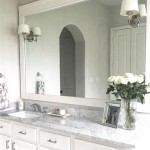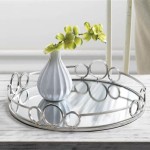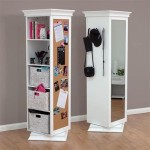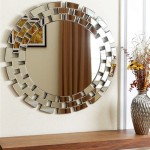How to Determine if a Mirror is a Two-Way
Mirrors serve as commonplace objects in both public and private spaces, used for personal grooming, interior decoration, and even security purposes. However, certain mirrors, known as two-way mirrors or one-way mirrors, possess the capability to allow viewing from one side while appearing as a standard mirror on the other. This article provides a comprehensive guide on how to identify a two-way mirror, outlining various methods that can be employed to ascertain its true nature. Understanding the distinction between a standard mirror and a two-way mirror is crucial in ensuring privacy and security.
The fundamental principle behind a two-way mirror lies in the difference in light levels on either side. The side designed for observation is typically kept dimly lit, while the side intended to appear as a standard mirror is brightly illuminated. This light disparity allows individuals on the darker side to see through the glass, while those on the brighter side only perceive a reflection. This effect is not inherent to the glass itself but rather a result of the lighting conditions and a thin, reflective coating on one side of the glass.
Before initiating any physical tests, a preliminary assessment of the surrounding environment is advisable. Consider the location of the mirror. Is it situated in a place where privacy is expected, such as a restroom, changing room, or hotel room? If so, heightened scrutiny is warranted. Secondly, observe the lighting conditions. Is the room on the "mirror" side significantly brighter than the adjacent room? These initial observations can raise suspicion and prompt further investigation.
Several practical methods can be employed to determine if a mirror is a two-way mirror. These methods range from simple visual inspections to more involved physical tests. Each technique leverages different properties of mirrors and light to reveal the presence or absence of a hidden observation point. Furthermore, it is important to note that even if one method proves inconclusive, employing multiple techniques can provide a more comprehensive assessment.
The Tap Test: Listening for Hollow Sounds
One of the most straightforward methods for identifying a two-way mirror involves a simple tap test. This test relies on the principle that a standard mirror is typically mounted directly against a solid surface, such as a wall. Conversely, a two-way mirror is often installed as a window separating two rooms, leaving a void behind the glass.
To perform the tap test, gently knock on the surface of the mirror with a knuckle. Listen carefully to the sound produced. A standard mirror will typically produce a dull, flat sound due to the backing against the wall. In contrast, a two-way mirror, with its empty space behind, is likely to produce a hollow, echoing sound. The difference in sound is often subtle but discernible with careful attention. It is advisable to repeat the tap test in several locations on the mirror's surface to ensure consistency and account for any variations in mounting or wall construction.
However, it is important to acknowledge the limitations of the tap test. The sound produced can be influenced by various factors, including the size of the mirror, the thickness of the glass, the construction of the wall, and the presence of sound-dampening materials. Therefore, while a hollow sound can be indicative of a two-way mirror, it is not definitive proof and should be corroborated with other testing methods.
Furthermore, some sophisticated installations of standard mirrors may incorporate a small air gap between the mirror and the wall to prevent condensation or provide ventilation. This air gap can inadvertently produce a hollow sound, mimicking the characteristics of a two-way mirror. Conversely, some two-way mirror installations may be tightly fitted, minimizing the hollow sound. Therefore, the tap test should be considered as an initial screening tool rather than a conclusive diagnostic technique.
The Finger Nail Test: Assessing Reflection Gaps
The finger nail test is another simple yet effective method for identifying potential two-way mirrors. This technique exploits the reflective properties of standard mirrors versus two-way mirrors. A standard mirror has a reflective coating applied to the back of the glass, whereas a two-way mirror has the coating applied to the front.
To perform the finger nail test, place a fingernail against the surface of the mirror. Observe the gap between the fingernail and its reflection. On a standard mirror, there will be a noticeable gap between the fingernail and its reflection due to the thickness of the glass separating the reflective coating from the surface. Conversely, on a two-way mirror, the fingernail will appear to directly touch its reflection, as there is no glass between the fingernail and the reflective coating.
The absence of a visible gap is a strong indicator that the mirror may be a two-way mirror. However, it is crucial to consider the potential for manufacturing variations and imperfections. Some mirrors may have thinner glass or a slightly different reflective coating process that can minimize the apparent gap. Therefore, it is advisable to examine the mirror in several locations and compare the results to ensure consistency.
The effectiveness of the finger nail test can also be affected by lighting conditions. Dim or indirect lighting may make it difficult to accurately discern the gap between the fingernail and its reflection. Therefore, it is recommended to perform the test under bright, direct lighting to enhance visibility. Additionally, individuals with poor eyesight may find it challenging to perform the finger nail test accurately without the aid of magnifying devices.
The Light Test: Observing Light Transmittance
The light test involves a visual inspection of the mirror's surface to assess its light transmittance properties. This method relies on the principle that a two-way mirror, by its nature, allows some light to pass through from one side to the other, albeit minimally. This test is most effective when the lighting conditions on either side of the mirror can be controlled.
To conduct the light test, turn off the lights in the room where the mirror is located. If possible, introduce a light source into the adjacent room. This can be achieved by turning on the lights in the adjacent room or by using a flashlight. Observe the surface of the mirror closely, looking for any signs of light transmission from the adjacent room.
If the mirror is a two-way mirror, a faint glow or silhouette may be visible on the surface of the mirror. This is because the light from the adjacent room is passing through the partially reflective surface. The amount of light that passes through will depend on the intensity of the light source and the reflective properties of the mirror.
Conversely, if the mirror is a standard mirror, it will completely block the light from the adjacent room, and no glow or silhouette will be visible. The mirror will appear dark and reflective. However, it is important to note that even a standard mirror may allow a minimal amount of light to pass through if it has scratches, imperfections, or a poorly applied reflective coating.
The effectiveness of the light test can be significantly enhanced by using a high-intensity flashlight. By shining the flashlight directly onto the mirror's surface from the adjacent room, any light transmission will be more readily apparent. Furthermore, using a darkened room on the "mirror" side enhances the contrast, making even faint light transmittance more visible.
It is crucial to be aware that some modern standard mirrors may incorporate advanced reflective coatings that can mimic some of the light transmittance properties of a two-way mirror. Therefore, the light test should be used in conjunction with other testing methods to provide a more comprehensive assessment. Additionally, the presence of dust, dirt, or fingerprints on the mirror's surface can interfere with the light test by scattering light and obscuring any potential light transmittance.
In summary, determining if a mirror is a two-way mirror requires a combination of careful observation, physical testing, and an understanding of the principles behind two-way mirror technology. By employing the methods outlined in this article, individuals can significantly increase their chances of identifying a two-way mirror and ensuring their privacy.

How To Detect A Two Way Mirror Fingernail Test

Lpt Always Do This Finger Test To Check For 2 Way Mirrors In Hotels And Changing Rooms R Lifeprotips

How Mirrors Work And To Test Two Way Glass The Horizon Sun
Is It Glass Or A Two Way Mirror The Balancing Act
How You Do A Quick Check For Cams Or Two Way Mirrors In Trial Rooms Quora

How To Tell If You Re In A Room Restroom Motel Etc With Mirror Or

How To Tell If A Mirror Is Two Way Or Not 8 Steps With Pictures

Forwarded Messages A Mirror Or 2 Way Glass Two Helpful Hints
How To Tell If A Mirror Is Two Way Or Not Quora
A Mirror Or 2 Way Glass








